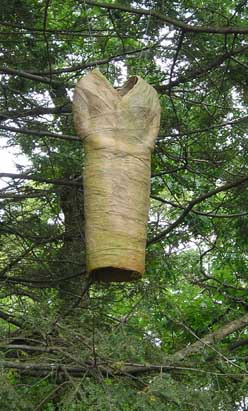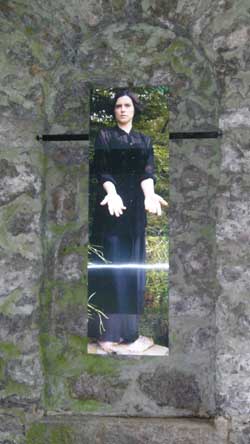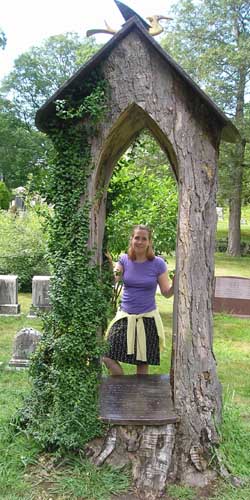
![]()
|
Index
• |
|
Welcome
• |
|
21st Century• The Future |
|
World
Travel• Destinations |
|
Reviews• Books & Film |
|
Dreamscapes• Original Fiction |
|
Opinion
& Lifestyle • Politics & Living |
|
Film
Space • Movies in depth |
|
Kid's
Books • Reviews & stories |
|
|
|
|
The International Writers Magazine :
How to Build a Cemetery
• Eric D. Lehman
A few years ago, my future wife Amy and I drove to Jamaica Plain, Massachusetts, to see the graves of a few famous writers. We turned into the long drive of Forest Hills Cemetery, coasting through tall, ornate stone arches, completely unprepared for what we found there. The trees were old and beautiful, beeches, white pines, and maples. Then, confusion, shock, wonder. A mummy-shroud dress hung from a pine tree, incongruously. Immediately I had thoughts of spooky rituals or gothic pranksters. It wasn’t until we noticed a metal deer with a genuine rack of horns bellowing at the sky and a bronze African prophetess sitting on a boulder that we understood this was art. It certainly had served its purpose, which was to jar us from our ordinary perceptions and cause us to rethink a trip to the cemetery.
After finding Anne Sexton’s grave on a small hillock and placing a stone on top, we drove around the hill and underneath a stone bridge. Something caught the corner of my eye and I backed the car up. Amy gave a yelp. Underneath a bridge on the two sides, the life-sized figure of a woman in black Victorian dress stood in two different poses in each ‘window.’ As we moved the car back and forth, the figures, called Fortitude and Despair, moved. The lenticular photographs were so well-done that Amy got creeped out and urged me to leave. It was the best example of art fitting into the landscape I’ve ever seen. Or perhaps I should say the landscape was fitting into art.
In fact, the cemetery was literally crawling with art of various forms, most of it designed directly for the location. After parking the car we sat briefly in chairs carved out of tree stumps and covered in poetry. As we walked around the small lake in the center of the cemetery, two green herons fished for their afternoon meal. Amongst the water-lilies was a strange metallic island, checkered like a chess board. A huge pole with dozens of birdhouses and feeders stood on the other side of the lake. We chatted, we speculated, we celebrated. Other visitors happily walked their dogs and played in the gigantic branches of the beech trees.
The poet e.e. cummings’ grave was on a hillside, just a small, flat stone plate in the ground. Though we were moved, it seemed less of a marker than the wonderful broken maple tree nearby, which had been carved out by a sympathetic artist. The space inside was about the size of a person, and a small gabled roof gave the small tree the appearance of a church. A copper plate lay across it, forming a seat surrounded by the chapel of wood.On the plate, a cummings poem was inscribed:
I thank You God for most this amazing
day: for the leaping greenly spirits of trees
and a blue true dream of sky; and for everything
which is natural which is infinite which is yes
(I who have died am alive again today,
and this is the sun's birthday; this is the birth
day of life and of love and wings: and of the gay
great happening illimitably earth)
how should tasting touching hearing seeing
breathing any--lifted from the no
of all nothing--human merely being
doubt unimaginable You?
(now the ears of my ears awake and
now the eyes of my eyes are opened)
It was a fitting tribute, not just to cummings, but to this cemetery itself. We could believe that cummings and the rest of the dead were "alive again today" because of the profound energy of this place. Who said that cemeteries needed to be sober and gray? Why not fill them with the joy of creation?
After searching for the hard-to-find grave of Eugene O Neill and paying our respects, we drove away from this amazing place, passing ethereal sets of clothes pinned to pine trees, forming a ghostly family. We waved, almost unconsciously. Who will visit my grave, I wondered, and will they find peace or disharmony? I could do worse than to be interred in the middle of the creativity and vitality that lives in Forest Hills Cemetery. The eyes of my eyes were opened to possibility now, to the idea that creative forces could transform the most somber of places, and that life was as important to cemeteries as death.
http://www.foresthillstrust.org/© Eric D Lehman September 2008
elehman@brgeport.edu
ERIC TEACHES CREATIVE WRITING AT BRIDPORT CONNArt for a rainy day
Eric D Lehman at The Clark Museum - Williams College
Trail Buddies
Eric D Lehman
Karma and friendship on White Mountain Trails
Call Some Place Paradise, Kiss it Goodbye
Eric D. Lehman won't tell you where he has been
Why keep the name of that town a secret?The reason is that this town isn’t sharable at all.
More world destinations
Home© Hackwriters 1999-2015
all rights reserved - all comments are the writers' own responsibility - no liability accepted by hackwriters.com or affiliates.



